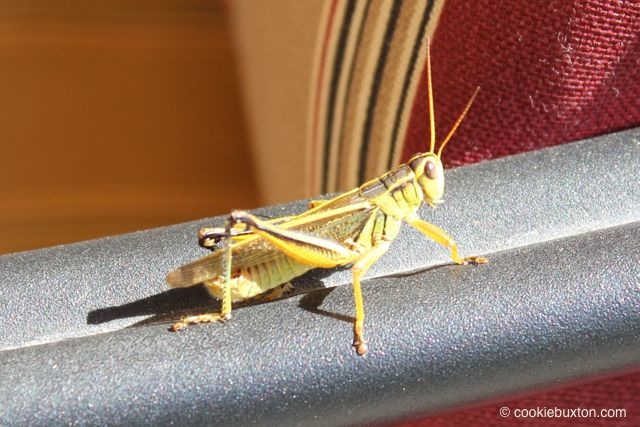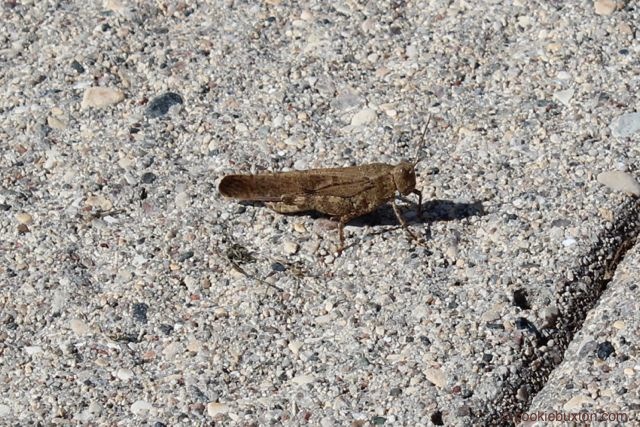Grasshoppers in the Garden

Above: Differentiated Grasshopper (perhaps)
As a result of some clear, dry weather, there were a fair number of grasshoppers in my yard this summer, appearing in August and lasting into October. I can’t say I am particularly fond of grasshoppers. When I see them, I often let out an involuntary little scream. My friend Daryl, however, also a gardener, welcomes seeing them. She reminds me that they are part of our ecosystem. Having grasshoppers in our gardens means that they are, to state the obvious, alive and well. In the big scheme of things, that is probably a good thing – especially if you think large insect-eating birds are entitled to a good meal now and then. Spiders also rank grasshoppers as belonging in the fine dining category, provided they catch them when they are small enough not to bring down the whole web.
Flies are also major predators of grasshoppers, or rather, controllers of the population of grasshoppers. Flies eat grasshopper eggs. There are other interesting aspects to the way flies lay their eggs that relate to grasshopper populations, and you can read about this on your own when you want some scary stories.
The main reason that I am nervous when I see grasshoppers in my urban garden is simply that they startle me when they leap. Never mind, for a moment, that they eat plants and crops. My issue is that they are kind of big and ugly and they leap all over the place. In fact, this is not quite true. They only leap in a forward direction.
This summer, however, I found myself changing my mind on the ugly label that I had always attached to grasshoppers. I managed to take a good photo of what is probably a differentiated grasshopper (yellow and brown with distinctive markings) – shown in the photo at the top of this article. I had a chance to admire this grasshopper’s gorgeous markings up close, got to see the structure of the compound eye (they have five eyes, in fact, which is why it is hard to sneak up on them) as well as the shape of the body and head. I found myself admiring the “architecture” of this interesting insect.
I also took a photograph, in my yard, of what is possibly the species called the Carolina grasshopper. It looks like a prehistoric creature designed for a Jurassic Park movie set. It really does look ancient, and its brown mottled markings offer perfect camouflage. Yet when this large grasshopper leaps and opens it wings, you can see its wide wingspan and striking wing colourations. It is quite a different creature when it is on the move. As well, if I am remembering correctly, and if I have identified the species correctly – out of the 400 or so in North America, and 10,000 plus around the world – this type of grasshopper is not one of the major pests affecting commercial crops and gardens. A dozen or two here and there are not a major issue. In fact, the insect-eating birds are happy to see them.
So, are a handful of grasshoppers a threat to our gardens? No. Are they a threat in the thousands? Yes. Grasshoppers are herbivores. In large numbers, grasshoppers, crickets, and locust swarms have wiped out field crops, devastated vegetable growth, and in years of drought, when breeding conditions were excellent, have been known to consume all of the vegetation in their paths – crops, vegetables, tree bark, leaves, and grass. The world goes hungry when grasshoppers get fat.
Enjoy a few grasshoppers in your yard. They are rather interesting. And if you have access to a camera, or have time to take a really good look, check out the type that you are seeing – some species of grasshopper are beneficial, eating noxious weeds that are poisonous to grazing animals.
If, however, the numbers climb too high – well, it’s time to attract the bigger birds to your backyard garden for a little grasshopper feast. Or if you are adventuresome, you could catch them, bake or fry them, and roll them in some chocolate. Grasshoppers provide more nutrients, kilogram for kilogram (pound for pound, for our southern neighbours) than beef burgers. Societies in Asia and Africa figured this out a long time ago.
As for me, all handsomeness and tastiness aside, I will put on some steel-towed boots, a parka, mitts, helmut, and a face mask, and I will stomp around in the yard with a huge home-made swatting tool, if I am pushed to it.
Photo below – possibly a Carolina grasshopper.

Photo ID: 1310_96 top photo, 1310_97 brown grasshopper
Photo location: Home garden, zone 3
Photo & text: NK
Copyright: cookiebuxton.com